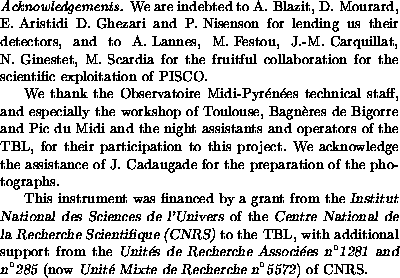Next: Bibliographie Up: Le tavelographe "PISCO" Previous: Etude de compagnons de miras
![]()
![]()
![]()
Next: Bibliographie
Up: Le
tavelographe "PISCO" Previous: Etude
de compagnons de miras
Bien que nous ayons eu souvent du mauvais temps qui nous a empeches de mener à bien les programmes d'imagerie d'objets complexes et certains programmes d'objets faibles, les années qui ont suivi la mise en service de PISCO au Pic du Midi ont montré la fiabilité de l'instrument et sa grande flexibilité avec ses différents modes d'observation.
Its versatility with multi-mode observational possibilities makes it particularly well suited to testing the new methods of image restoration which will be used by the future aperture synthesis arrays that are currently being built all over the world. The experience gained with pupil masks may have direct applications for reducing data from interferometric arrays.
The use of new observational facilities such as Adaptive Optics (AO) Systems will allow a full fledged use of the stellar coronagraphy mode in PISCO.
It could be objected that AO will finally make a term to the speckle observations. At present the AO systems still have rather poor performances in the visible domain (although some improvements are currently being made, as it is shown by some recent observations with the ONERA BOA at OHP, for instance). In any case, speckle observations in the visible can be a useful complement to a multi-wavelength program. The pre-main sequence program by J. Bouvier is a good example (cf. §6.4). The speckle techniques could also be used in association with AO to correct the residual errors of the AO images in the visible.
The good performances of speckle methods for binary star observations have lead to consequent orbit measurements during the last twenty years. This high efficiency makes speckle observations a ``privileged'' tool for binary studies. A new series of speckle programs have been impulsed by the discovery by Hipparcos of thousands of candidates for binaries (confirmation of binarity, orbits, variability of companions, etc). New space projects such as the space interferometers dedicated to parallax measurements (ESA GAIA) will also need follow-up based-ground observational programs in the future for which speckle techniques may significantly contribute.
